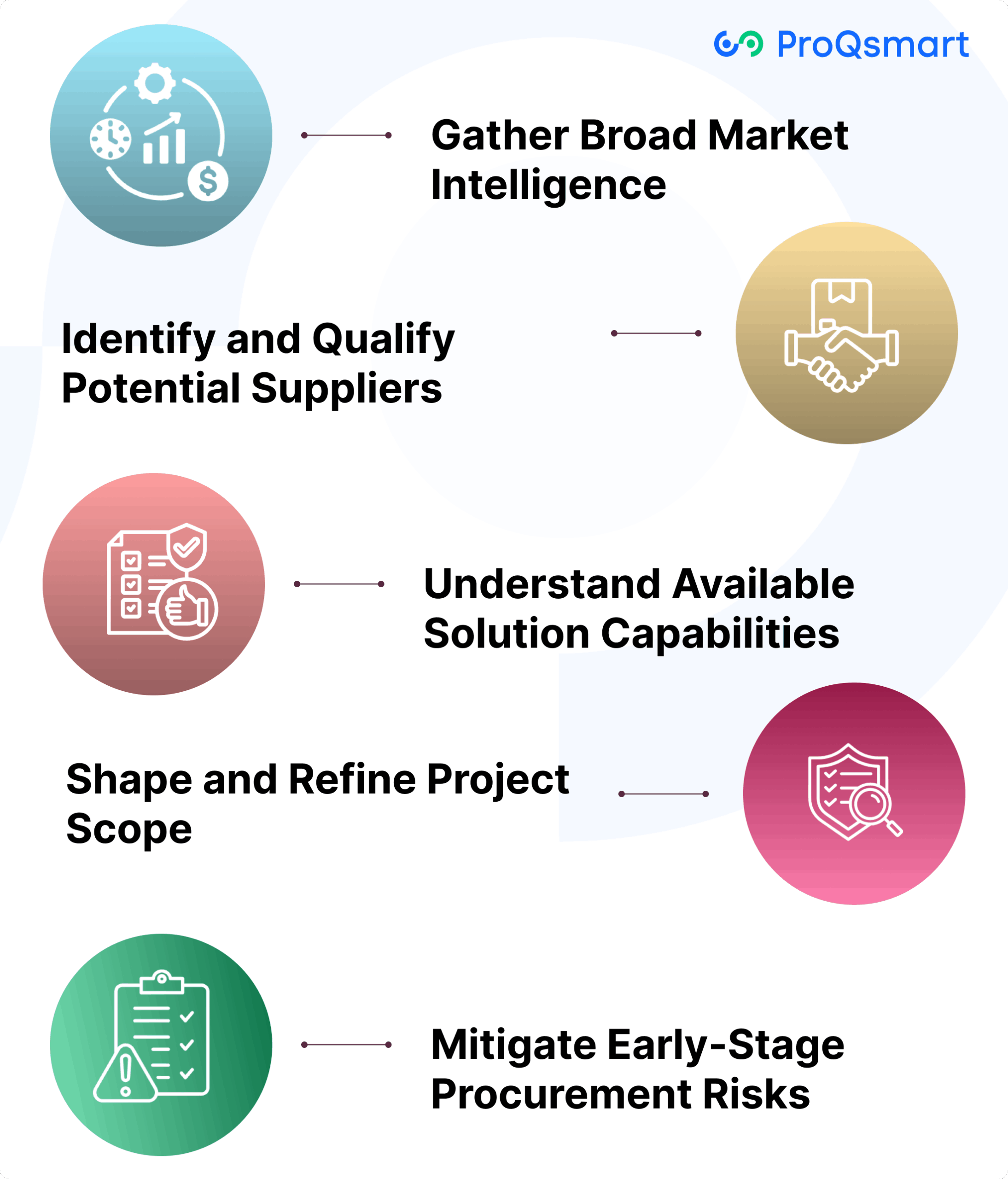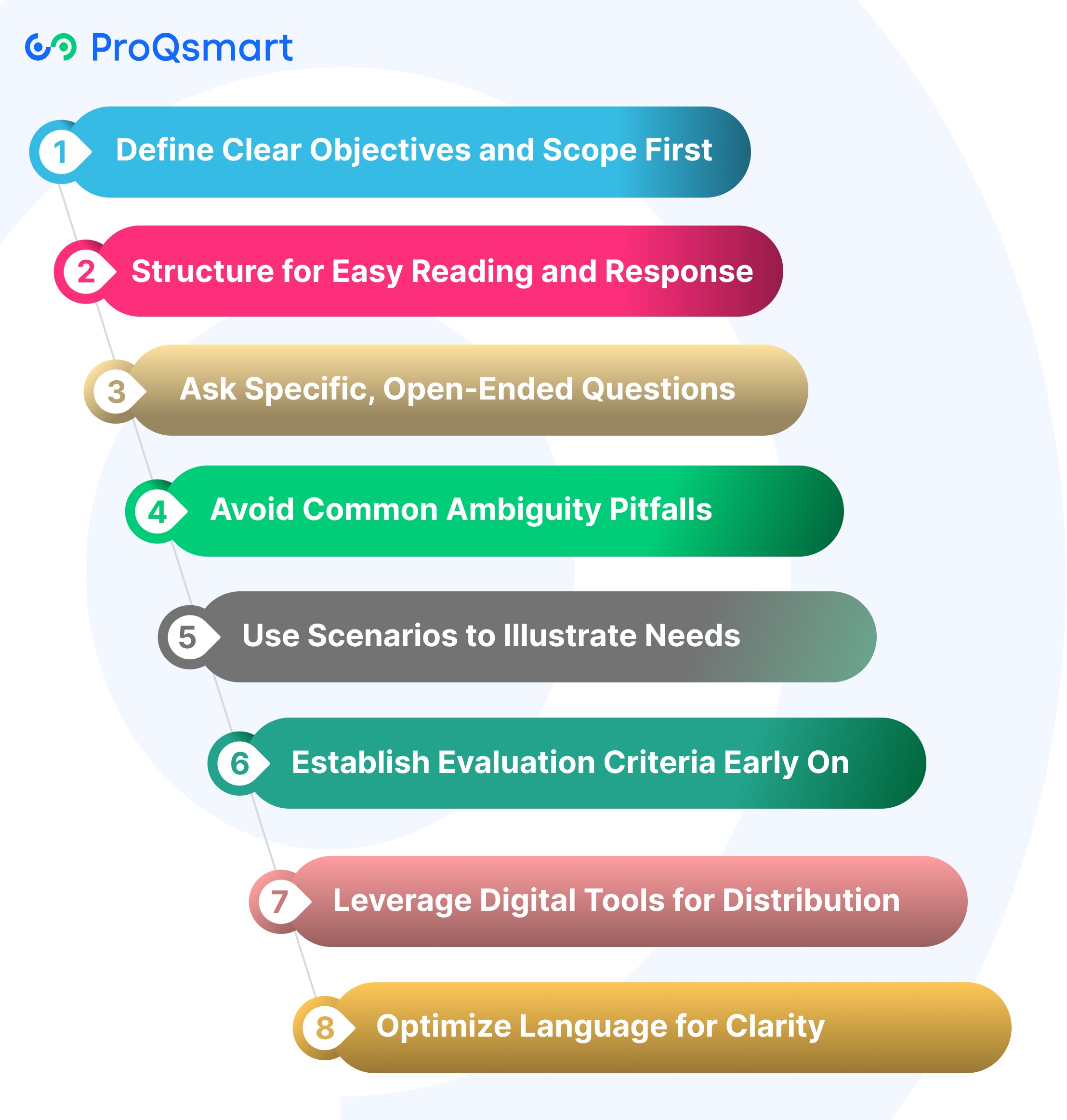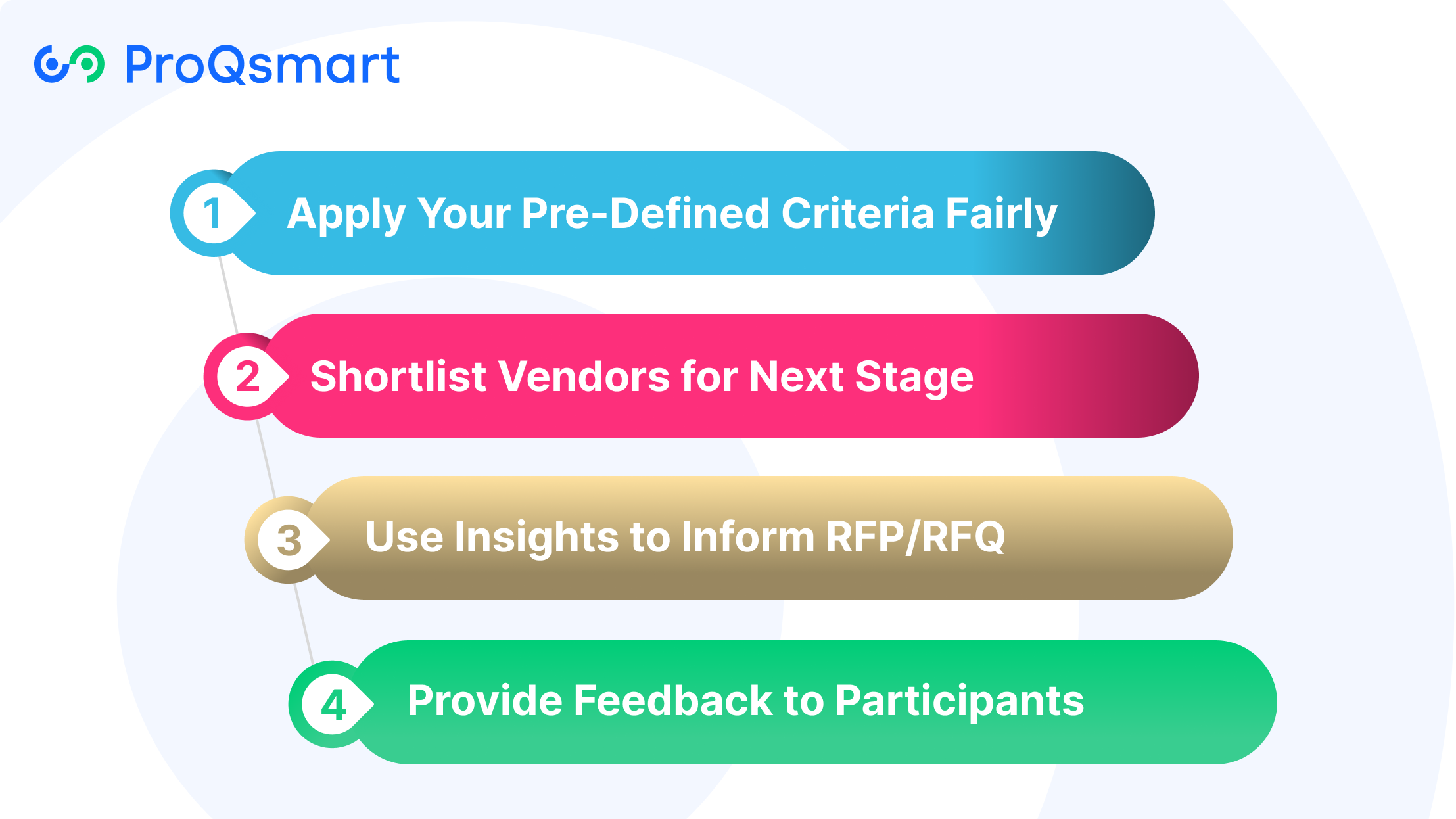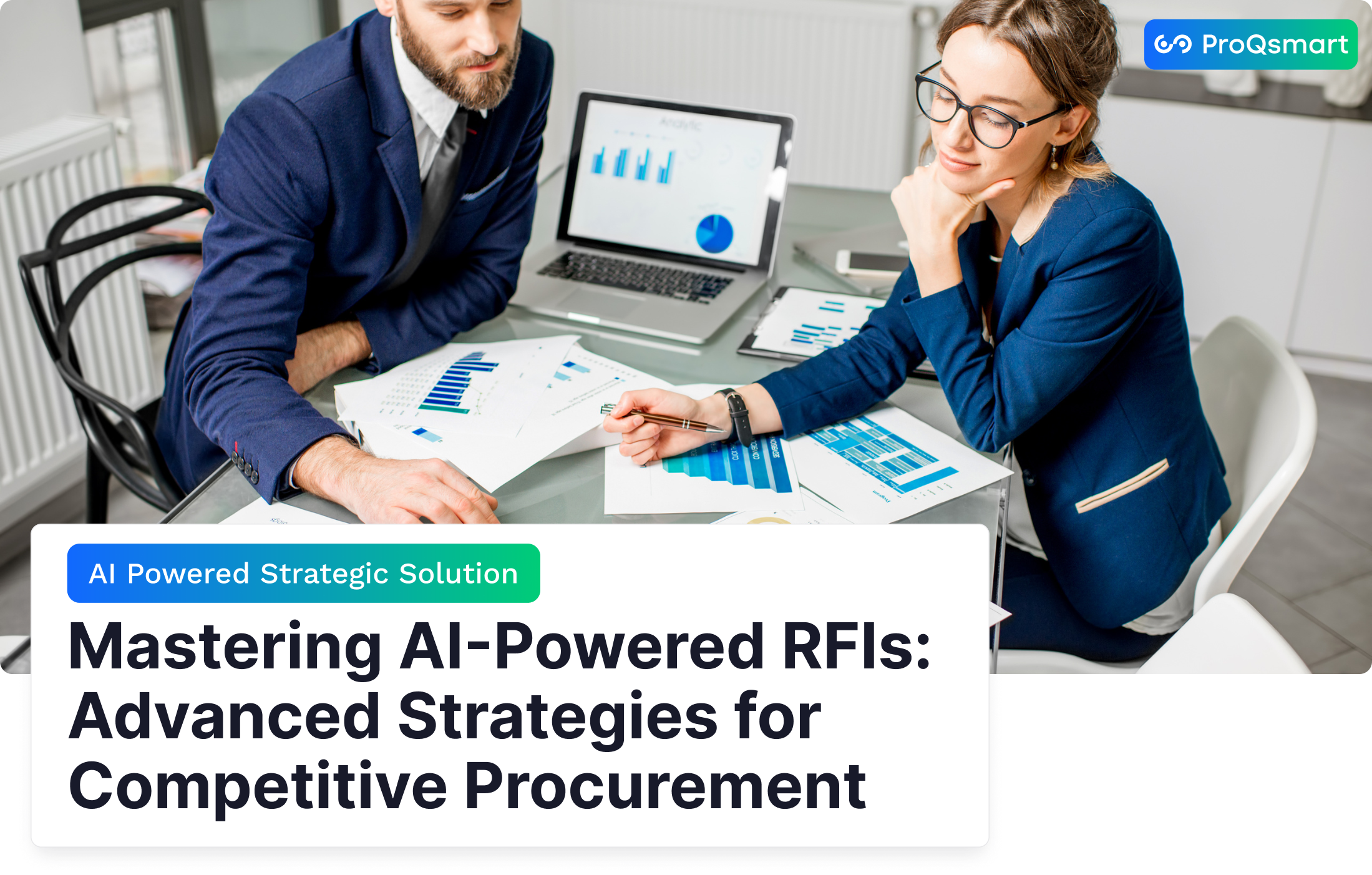Organizations are turning to AI-powered RFI (Request for Information) solutions to gain a decisive edge in procurement. Advanced automation and data-driven insights are transforming how procurement teams gather detailed supplier information, quickly identify the most qualified vendors, and streamline the early stages of sourcing. By leveraging intelligent tools, teams can efficiently draft RFIs, standardize questions, analyze responses, and ensure compliance—all while reducing manual effort and accelerating timelines.
As procurement becomes more strategic, mastering the RFI process with AI not only enhances efficiency but also drives better outcomes in supplier selection, risk mitigation, and project planning. This article explores how modern procurement can harness these technologies to optimize sourcing strategies, improve decision-making, and achieve superior project delivery.
What is a Request for Information (RFI)?
A request for information (RFI) is a very formal document. The tool helps procurement or sourcing teams collect facts from potential suppliers. They use it as a research tool to help them understand what else might be in the market.
This allows them to better calibrate their needs before going out to RFQ / RFP. RFIs can be useful for teams to gauge the skillset or expertise available from a vendor, allowing them to make informed decisions prior to entering an agreement.
Usually, an RFI arrives in written format and is sent to design, engineering, or construction professionals. This is why companies issue RFIs—to make sure that everyone is on the same page.
This saves them significant time and money from rework and errors in implementation later.
Strategic Goals of Using an RFI

This enables teams to easily request tangible information from vendors. This strategy fuels intelligent decisions and keeps all progress focused on achieving broader business objectives. RFIs are the first line of defense during procurement.
They allow businesses to identify market trends, evaluate suppliers’ capabilities, and improve quality and savings. Firms often see an average cost savings of 10-15% by integrating RFIs into their sourcing workflow. This kind of integration shows major dollar value.
The data and knowledge culled from RFIs arms businesses to satisfy stringent criteria. It further protects their data security and allows them to innovate and respond to quickly-evolving market demands.
Gather Broad Market Intelligence
RFIs invite such market-sounding opinions in a way that an RFP cannot. This allows teams to find innovative supplier solutions and stay ahead of the curve. By asking the right questions, they help themselves better understand what their competitors are doing.
They can then build off those findings to inform their own approach and goals. For example, a large consumer tech firm might publish a series of RFIs to collect information. They’re looking to find out how other companies are approaching rapid prototyping and sustainable sourcing.
Responses allow teams to establish benchmarks and create a short list of suppliers who excel to which teams can proactively turn for future projects.
Identify and Qualify Potential Suppliers
Professionals use RFIs as a tool to set standards for vendor selection. They take into account things like past performance on similar projects, size and scope of firm operations, and technical capabilities.
They can create a set of priorities, e.g., requiring ISO certification or a track record of success on similar projects. This step starts the important process of building relationships and understanding with new suppliers.
It prequalifies those who actually meet the set criteria, keeping the competition fair and focused.
Understand Available Solution Capabilities
RFIs serve an incredibly important purpose to allow teams to visualize the true range of tools, technology, and services available in the marketplace. An EV manufacturer could test battery technology or build quality from various suppliers.
Everything is documented in a centralized location, setting the stage to inform future proposals or project plans.
Shape and Refine Project Scope
Design teams utilize RFI feedback as an opportunity to further refine what a project truly requires. They work in concert with their essential partners to collect actionable feedback.
On the basis of that feedback from suppliers, they then reshape the plan. This ensures that the resulting outline addresses the business objectives as well as practical supplier expertise.
Mitigate Early-Stage Procurement Risks
RFIs allow teams to identify risks up front, such as weaknesses in a potential supplier’s expertise or indicators that they will not be able to execute. By cataloging and monitoring these flags, teams develop intelligent risk management strategies and create accountability documentation for the future.
Tools such as ProQsmart improve visibility and accessibility of these actions to facilitate improved collaboration and data security.
Crafting an Effective RFI Document

A thoughtfully constructed RFI document provides your team and prospective vendors a transparent, established route for obtaining essential information from vendors before the bidding process begins. This early step shapes project planning, helps teams set real goals, and builds a level playing field for all vendors.
Providing clarity, logical structure, and an emphasis on specific, detailed answers helps keep the process simple and fair for all competitors.
1. Define Clear Objectives and Scope First
As an initial step, project owners should clearly articulate what they hope to achieve with the RFI. Objectives might include learning about vendor skills, checking for fit with a new AI-driven platform, or seeing how a supplier handles green sourcing.
Articulating these objectives up front helps to guide the whole process. Including a brief bullet-point list of your main objectives—such as increasing brand awareness or reducing expenses—helps explain why the RFI is important.
Creating a well-defined project scope informs vendors on your expectations, allows them to focus their responses, and provides more actionable answers.
2. Structure for Easy Reading and Response
Dividing the RFI into short, clearly-labeled sections increases readability. A clear table of contents allows vendors to search for important topics quickly.
Numbered headings, such as “1.0 Project Scope,” help to keep everything organized. Numbered bullet points and fill in the blank forms allow vendors to provide pertinent answers.
Using this standardization approach across all RFIs, similar to beginning with a template, not only streamlines the review between vendors but promotes a faster review.
3. Ask Specific, Open-Ended Questions
Teams genuinely get more insightful answers when they leave their questions open-ended. For instance, they may inquire, “How will your firm mitigate project costs?” or “Tell us about your work using AI-driven tools.
Providing sample questions as bullet points will provide your vendors with an outline on which to build their responses. Ask questions that highlight your strengths, whether that’s in supplier management or workflow automation.
4. Avoid Common Ambiguity Pitfalls
Plain, straightforward language helps avoid ambiguity from the start. Creating a glossary of technical terms, proofreading for jargon, and having a fellow practitioner read through the draft first are all good practices.
This saves time in back-and-forth communication and allows vendors to respond more quickly.
5. Use Scenarios to Illustrate Needs
Providing specific, real-world scenarios such as needing to replace suppliers quickly or fulfill a large order on short notice helps vendors understand what they will be up against.
Requesting solutions customized to these sample scenarios tests their creativity and ingenuity at addressing complex issues. This real-world element ensures that in-their-own-words responses are the most relevant and helpful back to the project team.
6. Establish Evaluation Criteria Early On
Well-defined scoring criteria—whether it’s supplier experience, technology capabilities, or ability to manage costs—is key to establishing confidence.
Making known these rules in the RFI raises the standard. A points-based system ensures that all reviews are objective and free of personal biases.
7. Leverage Digital Tools for Distribution
Platforms such as ProQsmart allow your RFI to be shared, tracked and answered with the utmost ease. Innovative features such as e-tenders, real-time chat and automated workflow tools give your teams the ability to work more efficiently.
Secure online review portals help ensure vendor submissions remain secure from public release while speeding the review process.
8. Optimize Language for Clarity
Punchy prose, simple vocabulary, and a no-nonsense approach go a long way in protecting the integrity of the RFI. Having a fresh set of eyes can help to catch jargon or other errors.
A clear, concise, easy-to-read RFI goes a long way in establishing the expectations for high-quality vendor responses.
RFI vs. RFP: Key Differences Explained
RFIs, or Requests for Information, and RFPs, or Requests for Proposal, are two distinct tools in the construction industry. Understanding the difference between an RFI and an RFP, especially in the context of construction project management, empowers teams to choose the best tool for the job and get projects moving.
Purpose: Information Gathering vs. Solution Proposal
RFIs act as the first stage for teams who are ready to learn about new vendors. They allow project teams to better focus on the specifications that truly matter. They collect general information, such as a vendor’s capacity to fulfill fundamental requirements or provide specific functionalities.
RFPs follow, requesting detailed proposals related to a defined project. That ensures suppliers demonstrate in detail how they would achieve objectives and at what price. Picking the correct document helps everyone stay streamlined and makes it easier to compare all the options side-by-side.
Timing Within the Procurement Cycle
RFIs play a role early in the procurement cycle, typically as the second step following market research. They enable agencies to sift through the suppliers who don’t have the basic requirements to be considered.
Later on, RFPs are used once the scope of the project is more defined. The transition from RFI to RFP is the transition from discovery to decision. Teams use a timeline like: market research → RFI → RFP → contract.
Commitment Level Expected from Vendors
RFIs request more limited information from vendors, often just basic company and capability info. RFPs require much more, such as customized answers and comprehensive proposals.
Vendors frequently invest much more in RFPs, understanding these are connected to actual projects. This key difference informs how vendors react, earn buyer trust, and even compete in response to each.
Typical Next Steps After Each
After an RFI, teams look through responses and determine which suppliers to invite to participate in RFPs. A checklist helps: review responses, shortlist vendors, send RFPs, keep communication open.
Tools such as ProQsmart are designed to simplify this by automating various steps, providing real-time progress tracking, and maintaining an organized supplier database.
|
Feature |
RFI |
RFP |
|
Purpose |
Info gathering |
Project proposals |
|
Detail Level |
Basic |
High, project-specific |
|
Vendor Effort |
Low |
High |
|
Timing |
Early, pre-project |
Later, project-focused |
|
Next Steps |
Shortlist, send RFP |
Evaluate, select, contract |
Strategic RFI Use Cases Across Industries
In every industry, construction RFIs allow teams to develop a clear vision of what vendors are capable of providing. Over 43% of agencies use RFI documents to improve their procurement process. This demonstrates the common impact efficacy of this powerful tool to better inform decisions.
For the industries of manufacturing, construction, hospitality, and finance, RFIs give them the power to avoid expensive errors. They achieve this by setting demanding outcomes and revealing supplier capabilities from the outset. This clarity helps teams understand what’s possible with a project and spot contractors who fit their needs.
RFIs are used smarter across the board. In an example from manufacturing, teams utilize them to validate supplier capacity and ensure material specifications align with project requirements. In the construction industry, RFIs ensure plans adhere to local code, safety regulations, and approved materials.
In hospitality, RFIs campaigned for a better service and give hotels the opportunity to discover innovative solutions that upgrade experiences for guests. RFIs are important in banking and technology, where having an understanding of supplier risk and compliance is critical.
-
Manufacturing: Vet supplier production capability and material sources.
-
Construction: Check method compliance, material specs, and safety practices.
-
Hospitality: Assess service innovation and guest experience upgrades.
-
Finance: Review vendor stability and regulatory fit.
-
Technology: Probe cybersecurity and integration options.
With platforms like ProQsmart, teams can leverage AI to quickly organize RFI data, easily compare supplier bids, and effectively monitor supplier performance. ProQsmart allows organizations to automate workflows, manage compliance, and ensure procurement is aligned with actual budgets.
All these features help ensure that construction projects stay on schedule, foster supplier confidence, and enable project managers to maximize the value of every RFI.
Evaluate RFI Responses Strategically

A strategic evaluation of RFI responses helps to set the stage for powerful, data-informed decisions. Transportation teams that genuinely devote time and energy to this step find themselves with better qualified partners. They lower costs, reduce risks, and build better relationships with the supplier base.
Direct RFI formats even allow vendors to demonstrate solutions that align with an organization’s objectives, placing decision-makers on a path to explore options with enduring value. Teams can increase their pace and productivity by as much as 80% leveraging tools such as ProQsmart. Automated workflows and intelligent tools for tracking, reporting, compliance, and supplier prechecks open the door to this.
Apply Your Pre-Defined Criteria Fairly
Apply consistent scoring methodology consistently scoring. Teams review each RFI using checklists and scoring sheets that are created based on the standards agreed upon. This helps to prevent bias and maintains a level playing field during the process.
For instance, vendor experience, tech fit, financial health, and ability to deliver could all be weighted criteria. A simple 1 (poor) to 5 (excellent) rubric for each area rounds the scoring evenly. Openness in how scores are calculated and shared increases trust with vendors.
Shortlist Vendors for Next Stage
Qualified vendors should rise to the top by fulfilling the majority, if not all, of your established requirements. Most teams find it valuable to score responses and consider cost, past performance, compliance, project alignment, and other factors.
When communicating next steps, a few well-placed emails or phone calls establish the tenor of future connections. Key points for shortlisting: proven results, cost fit, strong references, and clear risk plans. Every step builds solid vendor relationships.
Use Insights to Inform RFP/RFQ
If you’re successful, every RFI will teach you something. Teams leverage these to refine subsequent asks, informing specifications and deliverable timelines. Key insights to include: vendor strengths, market trends, gaps in proposals, and best-fit tech.
These data-driven observations from rounds of RFI responses are a valuable resource for developing improved RFPs and RFQs.
Provide Feedback to Participants
Thorough and fair feedback will only enhance each vendor’s performance. Teams utilize concise construction RFI templates: thank you, main strengths, gaps, and next steps. Continuous engagement fosters a more conducive environment and trust for future information requests.
Conclusion
A well-executed RFI process is a powerful asset for any procurement team. By gathering objective, detailed information from potential suppliers early on, organizations can better understand vendor capabilities, spot potential issues before they escalate, and avoid costly project delays. Strategic use of RFIs reduces uncertainty, streamlines decision-making, and leads to stronger supplier partnerships and more competitive deals. Over time, a disciplined RFI approach becomes a clear competitive advantage—minimizing rework, boosting efficiency, and building trust with every engagement. Teams that continually refine their RFI strategy adapt faster to changing technologies and market trends, saving both time and resources along the way.
Ready to elevate your procurement process? Discover how ProQsmart can help you implement a smarter, more efficient RFI strategy—book your demo today.
FAQs
What is CapEx software?
CapEx software can help businesses with crucial capex budgeting by tracking and managing capital expenditures more efficiently and effectively. It monitors budgets, forecasts, and project approvals to deliver an easily understood visual representation for analyzing investment decisions. Digital tools such as ProQsmart help streamline capex management processes, making work more efficient and less prone to error.
Why is CapEx software important for construction management?
CapEx software streamlines capex management by alleviating the complexity of tracking construction project expenses. With ProQsmart ensuring capex planning stays on course, it reduces delays and enhances cross-team collaboration, delivering projects on time and within budget.
How does CapEx software improve project planning?
By tracking approvals and other key milestones, capex management software enables you to forecast costs with greater accuracy. By providing project managers with real-time insights, ProQsmart supports crucial capex budgeting decisions, ensuring projects remain on scope and budget.
What are the benefits of using ProQsmart's CapEx software?
ProQsmart’s CapEx software enhances productivity and collaboration while reducing the chance for human error. With streamlined capex management and real-time reporting, it empowers businesses to maintain control over their costs and deliver successful capital projects consistently.
How do I implement CapEx software successfully?
Start by evaluating your needs and choosing a solution like ProQsmart for streamlined capex management. Train your team, integrate it with existing systems, and monitor usage for effective capex planning.
Can CapEx software support strategic planning?
Yes, CapEx software such as ProQsmart allows transportation agencies to leverage capex planning and data-driven insights to plan for the long-term. This ultimate capex management tool empowers companies to better allocate resources, forecast budgets, and align their capex projects with overall business goals, helping to make smarter financial decisions.
Is ProQsmart suitable for small businesses?
You betcha. ProQsmart’s scalability and flexibility make it the perfect solution for companies of any size. Its intuitive tools streamline capex management, making capital expenditure planning a breeze and freeing up time and resources for small businesses to fuel their growth.




